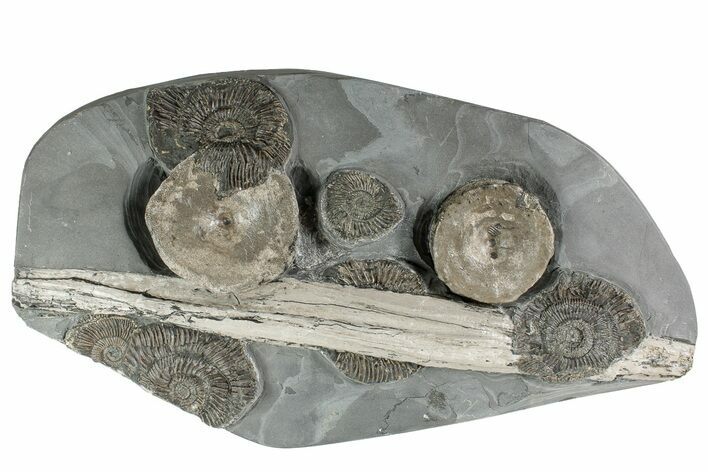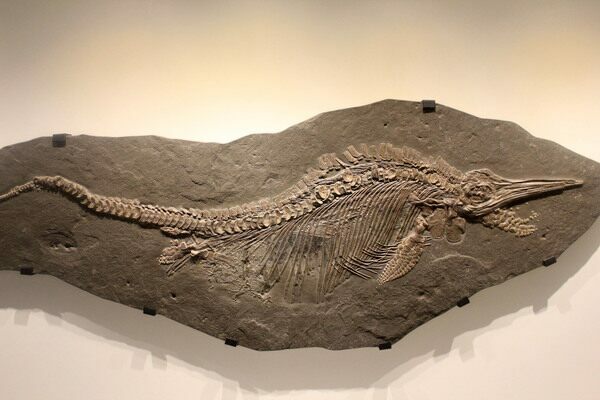This Specimen has been sold.
9.6" Fossil Ichthyosaurus Bones with Ammonites - Whitby, England
This is an alluring cluster of two ichthyosaur (Ichthyosaurus sp.) vertebrae that preserved next to a piece of ichthyosaur jaw and multiple ammonite (Dactylioceras sp.) fossils. These fossils are naturally associated and have been exposed from the rock they were found in, with most of the rock having been left behind for presentation purposes. It was collected from the Lower Lias - Falciferum Zone at North Yorkshire in England.
It comes with an acrylic display stand.
It comes with an acrylic display stand.
Ichthyosaurs were swordfish-like marine reptiles of the order Ichthyosauria. They had torpedo-shaped bodies with long, narrowly pointed jaws, large pectoral fins, and crescent-shaped tails. They were the high-speed predators of the Jurassic seas, indicating they ate a fish diet. This is confirmed by analysis of coprolites (fossil feces). They evolved about 250 million years ago, hitting their diversity apex during the Jurassic: there are currently 97 known genera. They may be descended from diapsids like dinosaurs and birds, but a recent theory suggests they may have descended from a distant relative of turtles. Ichthyosaurus had disappeared from the fossil record by about 90 million years ago. It is not known why they died out.
Ichthyosaurs are not fish. Their resemblance to them is an example of two groups adapting to their environment with similar adaptations without having a common ancestor, otherwise known as convergent evolution. Ichthyosaurs were reptiles with lungs that had to surface to breathe, while fish have gills that take dissolved oxygen from water. Ichthyosaurs looked like swordfish or dolphins: their bodies were larger near the head and tapered to a sleek, crescent-shaped tail.
Ichthyosaurs had one of the largest eyes relative to body size of any organism. This may allowed them to better move throughout the water column to find prey, reaching tremendous speeds with their crescent tails. Some estimates put the top speed of the fastest species above 30 miles per hour. Like most fish living today, Ichthyosaurus was likely dark colored on its back and sides and light on its belly as a form of camouflage.
Ichthyosaurs are not fish. Their resemblance to them is an example of two groups adapting to their environment with similar adaptations without having a common ancestor, otherwise known as convergent evolution. Ichthyosaurs were reptiles with lungs that had to surface to breathe, while fish have gills that take dissolved oxygen from water. Ichthyosaurs looked like swordfish or dolphins: their bodies were larger near the head and tapered to a sleek, crescent-shaped tail.
Ichthyosaurs had one of the largest eyes relative to body size of any organism. This may allowed them to better move throughout the water column to find prey, reaching tremendous speeds with their crescent tails. Some estimates put the top speed of the fastest species above 30 miles per hour. Like most fish living today, Ichthyosaurus was likely dark colored on its back and sides and light on its belly as a form of camouflage.
About Ammonites
Ammonites were ancient marine cephalopods, similar to today's squids and octopuses, but with a defining feature: their distinctive, tightly coiled spiral shells. These shells, resembling those of modern nautiluses, served as both a protective home and a buoyancy aid, allowing ammonites to navigate the prehistoric seas with ease. First emerging around 240 million years ago in the Triassic Period, ammonites thrived for over 175 million years, adapting through numerous forms and sizes. As predatory creatures, they likely fed on smaller marine organisms, using their tentacles to capture prey. However, their long reign came to an end 65 million years ago at the close of the Cretaceous, coinciding with the mass extinction event that also eliminated the dinosaurs.
Ammonites were ancient marine cephalopods, similar to today's squids and octopuses, but with a defining feature: their distinctive, tightly coiled spiral shells. These shells, resembling those of modern nautiluses, served as both a protective home and a buoyancy aid, allowing ammonites to navigate the prehistoric seas with ease. First emerging around 240 million years ago in the Triassic Period, ammonites thrived for over 175 million years, adapting through numerous forms and sizes. As predatory creatures, they likely fed on smaller marine organisms, using their tentacles to capture prey. However, their long reign came to an end 65 million years ago at the close of the Cretaceous, coinciding with the mass extinction event that also eliminated the dinosaurs.
SPECIES
Ichthyosaurus sp. & Dactylioceras sp.
LOCATION
Kettleness, Whitby, North Yorkshire, England
FORMATION
Lower Lias, Falciferum Zone
SIZE
9.6 x 5.3" rock, Largest Vertebra: 2"
CATEGORY
SUB CATEGORY
ITEM
#240843
We guarantee the authenticity of all of our specimens.
 Reviews
Reviews














